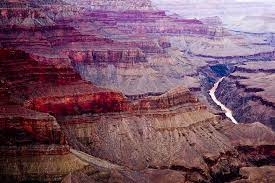
Two separate geologic stories exist at Grand Canyon. The older story is the one revealed in the thick sequence of rocks exposed in the walls of the canyon. These rocks provide a remarkable record of the Paleozoic Era (550-250 million years ago). Scattered remnants of Precambrian rocks as old as 2000 million years can also be found at the bottom of the canyon. The story these rocks tell is far older than the canyon itself. Mesozoic and Cenozoic rocks (250 million years old to the present) are largely missing at Grand Canyon. They have either been worn away or were never deposited.
The second geologic story at Grand Canyon concerns the origin of the canyon itself: when and how did it come to be? On one level the answer is simple: Grand Canyon is an erosional feature that owes its existence to the Colorado River. Of equal importance are the forces of erosion that have shaped and continue to shape the canyon today. These include running water from rain, snowmelt, and tributary streams which enter the canyon throughout its length. The climate at Grand Canyon is classified as semi-arid. The South Rim receives 15 inches/38 cm of precipitation each year. The bottom of the canyon receives 8 inches/20 cm. The rain comes suddenly in violent storms, particularly in the late summer of each year. The power of erosion is therefore more evident here than in other places which receive more rain.
Grand Canyon owes its distinctive shape to the different rock layers in the canyon walls. Each responds to erosion in a different way: some form slopes, some form cliffs, some erode more quickly than others. The vivid colors of many of these layers are due mainly to small amounts of various minerals. Most contain iron, which imparts subtle shades of red, yellow, and green to the canyon walls. Climate plays an important role in the appearance of the canyon. If there was a higher amount of precipitation at Grand Canyon, the plants and trees that grow here would be very different. The canyon walls might be covered with lush vegetation, rather than the cacti and shrubs growing there today.
Credit : GrandCanyon.com
Picture Credit : Google




